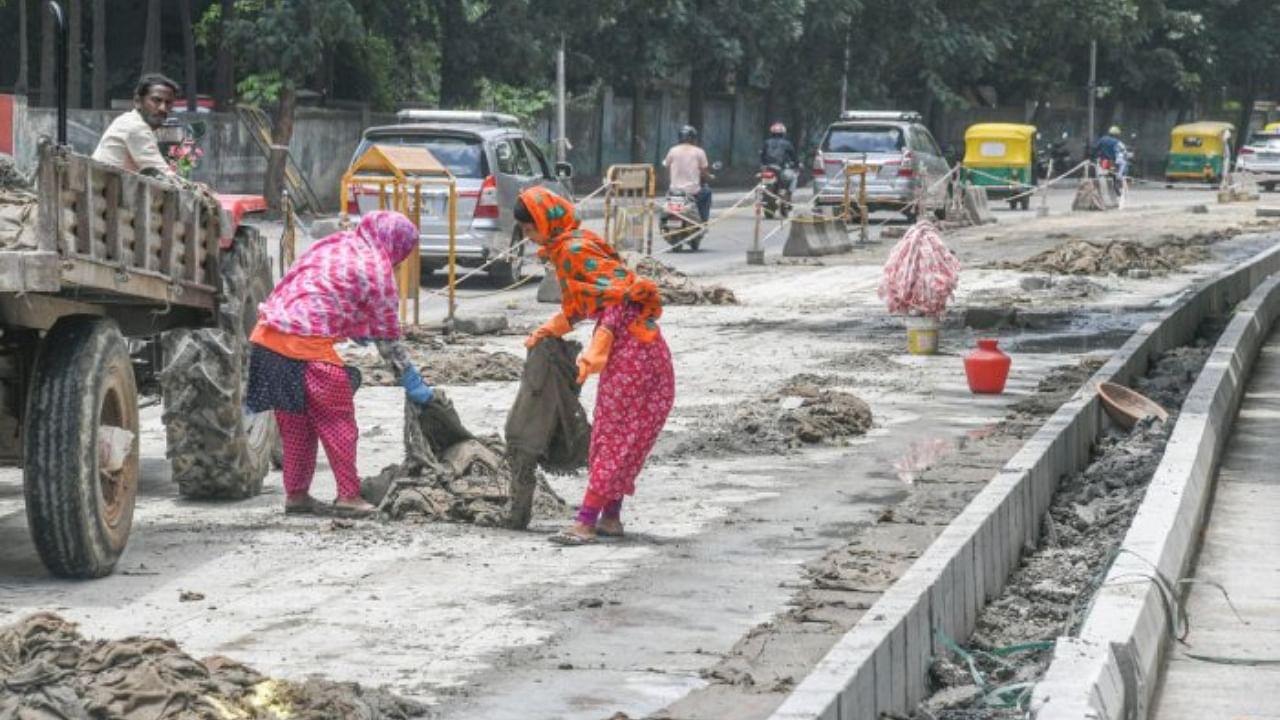
As the Qatar World Cup looms, a section of the international media is talking about the way workers from the sub-continent are treated there -- the kafila system, low wages, dismal working conditions and lack of infrastructure for the workers. The Indian media, however, is mostly silent. Perhaps this is a reflection on how we treat our construction workers in India and their living conditions.
Walk down any street in Bengaluru and chances are you will see a new building being built. Usually, a site will have 4-5 people working on the building. Typically, a contractor will appoint a resident worker on the site housed in temporary and poorly constructed shelters -- a small room and an outhouse. Many workers come with their families. Women help with moving bricks and other materials throughout the construction period.
It is common to see little children imitating, even helping, their parents. Given the short timeframe associated with construction, children are rarely sent to schools in the city. Once the children are old enough, the families move back to their villages so children can perhaps go to school. But while in the city, they have poor access to services such as education, water, sanitation, and health.
On larger construction sites also, workers deal with poor accommodation, bad sanitation, stressful working conditions, poor social life, long work hours, low wages, and unsafe work environments, and social isolation. While adults often suffer from diseases, children suffer from malnutrition, cholera, respiratory conditions as they inhale paint fumes and cement/dust particles. All are prone to accidents. Typically, because workers are migrants, they are excluded from primary healthcare facilities. Some construction firms, however, ensure healthcare facilities, but this is limited.
In Bengaluru, several studies show, most construction workers are migrants from Bihar, UP and Bengal, are largely men, aged between 21 and 35 years, from impoverished families, often from SC/ST and minority backgrounds and are mostly illiterate. Most come to the city alone and bring their families only when they feel settled. In their villages and hometowns, too, they have little access to education or livelihoods and migration is often the only survival strategy available. At workers’ mandis, where they pick up daily/ weekly work, the haggling over their daily labour rates is a window to the exploitation workers face. Women are almost non-existent in this exercise because of exploitation and security issues.
How we treat our workers, how they are paid, the final amount they receive, how they are housed and our everyday interactions with them says a lot about us, as a people and a society. The casualness with which workers are mistreated is problematic and reflective of our society.
During the pandemic, many of the men and women walking miles back to their villages and towns were construction workers. While many came out to help them during the immediate aftermath of the lockdown, not much has been done to remedy the structural reasons for the treatment received
by them.
We have laws, the Building & Other Construction Workers’ Act, 1996, but they are ineffective. Technically, every state has a Welfare Board that pays compensation for disability or death of a worker, provides healthcare benefits, sanctions assistance for weddings or funerals, provides loans for house construction, maternity benefits to female beneficiaries, pension, etc.
However, local governments do not have mechanisms to register workers with the boards and employers feel no obligation to do so. In 2014, the Karnataka Welfare Board registered a mere 30% of all workers. While Karnataka Building & Other Construction Workers’ Welfare Board collected more than Rs 3,000 crore as cess from the construction industry in 2014, it disbursed only a small amount to workers. Loopholes in the law place no onus on employers/contractors to ensure that school-age children are sent to schools. Builders need to provide crèches only where 50 women workers are employed, which typically never happens. Due to the migratory nature of workers, non-profits find it hard to organise them. Post Covid 19, a few organisations made demands of the Welfare Board to little avail.
Perhaps, it is time to engage in more empathy for the Indian worker on our home soil. If every homeowner, developer, architect, contractor, politician and neighbour took small steps by providing better housing, sanitation, education and childcare to the workers on their construction sites, perhaps there is a chance of bettering the conditions of our people. Only then can we complain about how Qatar is treating our people.
(The writer is an urban planner based in Bengaluru)